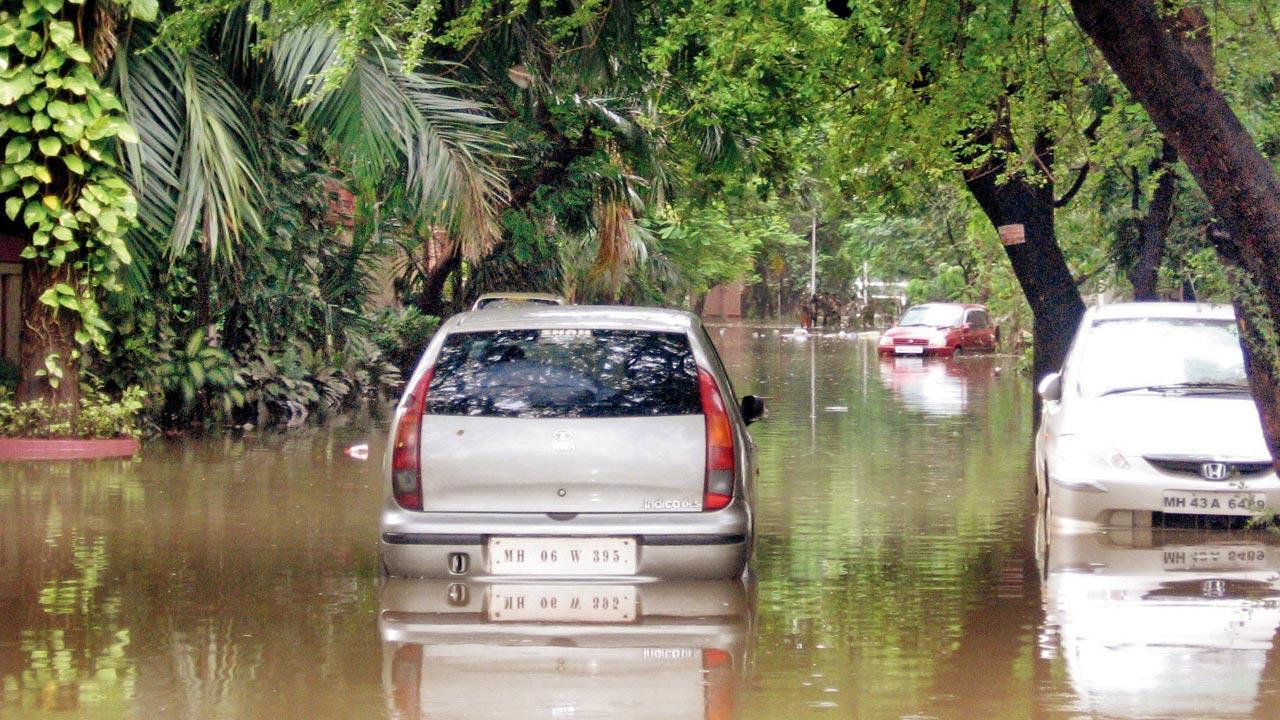For a city that ranks high on every list of places vulnerable to climate impact, the absence of panic is baffling

Flooded cars on a city street after the July 2005 floods. I am old enough to remember what happened on July 26, 2005, when approximately three feet of rain led to the loss of over a thousand lives. It is a tragedy that taught us little though. File pic
 The annual chatter surrounding Bombay’s monsoons would be amusing if it weren’t so frightening. I have been thinking about it more than I usually do, given how wrong the predictions of poor rainfall were this year. It has been decades since I took official weather reports seriously, but 2024 was wider off the mark than usual. Everyone was asked to brace for drier weather until the city promptly drowned, and then drowned again. By the time thunderstorms occurred in mid-October, I prayed for climate change deniers to be stuck outdoors without an umbrella.
The annual chatter surrounding Bombay’s monsoons would be amusing if it weren’t so frightening. I have been thinking about it more than I usually do, given how wrong the predictions of poor rainfall were this year. It has been decades since I took official weather reports seriously, but 2024 was wider off the mark than usual. Everyone was asked to brace for drier weather until the city promptly drowned, and then drowned again. By the time thunderstorms occurred in mid-October, I prayed for climate change deniers to be stuck outdoors without an umbrella.
ADVERTISEMENT
Scientists have been issuing warnings about Bombay for a while now. And by scientists, I mean people who have really studied science, not Entire Political Science graduates discussing how cloud formations occur. The warnings have a lot to do with how Bombay came into being, because we forget that it was once part of the sea. Remembering that crucial piece of information is difficult in a country that pays more attention to cricket than to history. So, for those still in denial, a reminder: seven islands were stitched together to create India’s financial capital, land was magically procured from the sea and, over time, residents convinced themselves that the water would stay away and forget to flow the way it used to.
A month ago, residents of Bangalore found out the hard way that water doesn’t forget. It’s why a 300-acre tech park reportedly built on the banks of a lake flooded. Bombay, meanwhile, continues to stay blissfully oblivious. It’s why multiple lists about cities most vulnerable to climate change are willfully ignored, why water bodies continue to be filled in for the benefit of real estate barons, and why rivers that once ran through the city have been reduced to sluggish streams without fear of any consequences.
The rains this year may be a distant memory by the time 2025 comes around, but the threat of severe flooding is predicted to become an annual event thanks to what scientists call ‘intense rainfall events’. There are more cyclones set to appear in the Arabian Sea, and a rise in sea levels that could be catastrophic for a city that has lost over 60 per cent of its open space over the past two decades alone.
I sometimes feel as if more residents of high-rises need to spend time in low-lying areas. Yes, there are shocking images and videos across social media to inform us of what happens in these parts when it rains, but the temporary horror of seeing everything come to a stop does nothing to evoke the kind of empathy that is so critical for good public policy. It is this missing empathy that prevents politicians and bureaucrats from making the kind of changes that can prepare Bombayites for a doomsday scenario that is no longer a question of ‘if’, but ‘when’.
It’s also why we should spend a little more time worrying about the Mithi River than we currently do. Its name crops up a few months before every monsoon when the government puts out reports about lacklustre cleaning efforts. We forget about it almost instantly, when what we should be doing is monitoring how water flows across and below every part of Bombay. We should obsess over groundwater levels and storm drains and ask more questions about why floodplains are being replaced by office complexes. We should also worry about whether any of this is being taught in schools, because I know it wasn’t when I was little. The most important thing to keep in mind is how the way we treat water resources today can define the kind of future available to our children.
Bombay is more a city of concrete than ever before. We pay more attention to building than to what concrete can do to the atmosphere. We have years of extreme precipitation ahead of us, along with the possibility of serious cyclones—the kind now routinely battering cities across America. The extended monsoon of this year will soon be the norm, not the exception, which is why there must be more conversations about the weather than we currently accommodate in our national and regional discourse.
I am old enough to remember what happened on July 26, 2005, when approximately three feet of rain led to the loss of over a thousand lives. It is a tragedy that taught us little though, which is why every scenario predicted for the next 20 years frightens me. It should frighten all of us.
When he isn’t ranting about all things Mumbai, Lindsay Pereira can be almost sweet. He tweets @lindsaypereira
Send your feedback to mailbag@mid-day.com
The views expressed in this column are the individual’s and don’t represent those of the paper
 Subscribe today by clicking the link and stay updated with the latest news!" Click here!
Subscribe today by clicking the link and stay updated with the latest news!" Click here!







